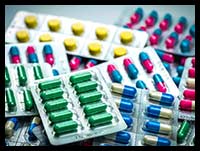 Antibiotics – Are substances of biological or semi-synthetic origin. Used in medical practice to fight against pathogenic microbes, viruses. Before the advent of these medicines, the status of incurable diseases was that of typhoid, dysentery, pneumonia, tuberculosis. Today the treatment of infectious diseases is possible with the use of 1-6 generation antibiotics.
Antibiotics – Are substances of biological or semi-synthetic origin. Used in medical practice to fight against pathogenic microbes, viruses. Before the advent of these medicines, the status of incurable diseases was that of typhoid, dysentery, pneumonia, tuberculosis. Today the treatment of infectious diseases is possible with the use of 1-6 generation antibiotics.
At this moment, the pharmacological industry produces more than 2000 varieties of drugs of this type. Medics have described the action of about 600 positions, and in medical practice about 120-160 drugs are used.
Important! For any disease, it is recommended to take antibiotics after consulting your doctor. Otherwise, antibiotic resistance (decreased sensitivity of pathogenic microorganisms to antibacterial agents) may develop.
Contents
Classification of antibiotics
All antibacterial agents can be divided into 5 categories according to their characteristics and spectrum of use. Let’s consider this classification in more detail:
Spectrum of action
We distinguish between antibacterial agents:
- Broad range of action – They are prescribed for diseases of an infectious nature with an unspecified cause of ailment. Bactericidal drugs because they kill all pathogenic flora.
- narrow range of action – Kills Gram-positive bacteria (enterococci, listeria). After taking them, they also kill Gram-negative infectious agents: E. coli, Salmonella, Proteus, etc.д. This group also includes anti-tuberculosis, anti-tumor, anti-fungal agents.
Composition
Antibacterial drugs are divided into 6 groups:
- Penicillins – The first antimicrobials, obtained as early as 1928 from a biological substance (Penicillium fungi). Long remained the most popular drug for treating infectious diseases.
- Cephalosporins – Are one of the strongest antimicrobials on the market and have a wide range of uses. Completely destroys pathogenic flora and is well tolerated by humans.
- Macrolides – Is the name of a group of narrow-range antimicrobials. Do not destroy the diseased cell, but only stop its growth. Drugs in this category include: erythromycin, spiramycin, azithromycin.
- Tetracyclines – Good drugs for treating infections of the respiratory as well as the urinary tract.
- Fluoroquinolones – Broad-range antimicrobials. Destroy pathogens completely. One to two generations of medications are commercially available. Doctors usually prescribe them to fight Pseudomonas aeruginosa.
- Aminoglycosides – Antimicrobial drugs with a wide range of uses. Popular drugs in this group – Streptomycin (therapy of tuberculosis, plague) and gentamicin – Used as ointment, eye drops, and injections for ophthalmic infections.
Generations of drugs. Advanced antimicrobials already have six generations. For example, penicillin was the first naturally occurring agent, while the third or sixth generation – is an improved version that incorporates the strongest inhibitors. The relationship is direct: the newer the generation, the more effective the medications are in attacking pathogenic microflora.
By the method of administration. Oral – taken by mouth. These are different syrups, tablets, soluble capsules, suspensions. Parenteral – Are given intravenously or intramuscularly. They have a quicker effect than oral medicines. Rectal preparations are given into the rectum.
Important! Antibiotics should only be taken after consulting a doctor, otherwise antibiotic resistance will develop.

New generation antibiotics
The difference between the latest generations of antibiotics and their earlier versions is a more advanced formula of the active ingredient. The active ingredients specifically eliminate only pathological reactions in the cell. For example, a new generation of intestinal antibiotics does not disrupt the microflora of the gastrointestinal tract. At the same time, they fight the entire «army» of infectious agents.
The latest antibacterial drugs are divided into five groups:
- Tetracycline – Tetracycline.
- Aminoglycosides – streptomycin.
- Penicillin series – amoxicillin and others.
- Amphenicols – chloramphenicol.
- Carbapenem group – meropenem, imipenem, invas.
Let’s take a look at some well-known antimicrobials.
Amoxicillin – Imported antimicrobial from the penicillin group. Used in medical practice to treat bacterial infections. Effective against intestinal infections, maxillary sinusitis, sore throat, Lyme disease, dysentery, sepsis.
Moxifloxacin– Latest generation medication of fluoroquinolone group. It has the strongest action on bacterial and atypical pathogens. Does not harm the kidneys or the gastrointestinal tract. Used for acute, chronic conditions.
Cephalosporins – Third-generation antibiotics. This group includes Ceftibuten, Ceftriaxone and others. They are used to treat pyelonephritis, pneumonia. In general, these are safe means with few side effects. However, they should only be taken after consulting a doctor. There are many medicines to choose from – will be recommended by a specialist.
Doripenem – Imported antimicrobial agent of synthetic origin. Has shown good results in the treatment of pneumonia, neglected intra-abdominal infections, pyelonephritis.
Ertapenem – An antibacterial agent of the carbapenem group. Available in ampoules for parenteral use. Shows rapid action in the treatment of bacterial skin disorders, soft tissue infections, urinary tract infections, pneumonia, septicemia.
Augmentin – Third-generation semisynthetic penicillin with the addition of enhancing inhibitors. Pediatricians consider it to be the best combination medication for treating children’s maxillitis, bronchitis, tonsillitis, and other respiratory tract infections.
Cefamandole – It belongs to the group of third generation cephalosporins. Used for treatment of intestinal infections, genital infections. As a broad-range antimicrobial used for colds.

The best broad-range antimicrobials
New generation antimicrobials are usually synthesized from natural raw materials and stabilized in laboratories. This helps strengthen the drug’s effect on pathogenic microflora.
What are the strongest antimicrobials? Doctors refer to such antibacterial agents of a wide range of effects. Here is a brief list of drugs by name:
- Amoxicillin + clavulanic acid – Belongs to the group of aminopenicillins. Gentle in action, used to treat infectious diseases. With caution, and only after consultation with a doctor, the drug can be used during pregnancy, as well as during breastfeeding. Available in tablets or in powdered form for oral administration, as well as in powders for injection.
- Azithromycin – A popular antimicrobial for the treatment of infections of the gastrointestinal tract, the urogenital system, respiratory tract diseases – Angina, bronchitis, pneumonia. Affects the liver and kidneys, so it is not prescribed to patients with hypersensitivity to macrolides.
- Cefoperazone – Part of a group of cephalosporins. Prescribed by doctors to treat urinary tract infections, prostatitis, skin disorders, respiratory diseases. Good drug for recovery after gynecological, orthopedic and abdominal surgery. Available as a parenteral product – Injections.
- Doxycycline – Latest generation tetracycline. Used for extensive treatment of gastrointestinal infections, colds, prostatitis. Gentle in action, does not cause dysbacteriosis.
- Lincomycin – A drug that is prescribed for the treatment of osteomyelitis, sepsis, staphylococcal infections. It has the strongest effect on pathogenic cells, so it has a long list of side effects. Among them – Hypotension, weakness, dizziness. It should not be used during pregnancy and in patients with hepatic and renal insufficiency.
- Roxithromycin – Fourth generation macrolide. It is prescribed for urogenital infections, gastrointestinal diseases and upper respiratory tract diseases. It is available in tablets.
- Cefixime – It is a drug of the cephalosporin group by name. It has a bactericidal effect on pathogenic cells. Helps with gastrointestinal infections, prostatitis, and colds. Toxic enough not to be taken if you have kidney or liver problems.
- Cefotaxime – The last group of cephalosporins. The drug is indicated for the treatment of gynecological, urological, colds. Excellent against inflammatory processes, suppresses pathogenic microflora.
Summary
We reviewed broad-spectrum antibiotics, briefly described the classification of drugs. Let’s answer the question: what antibacterial agents to choose?
It is important to understand, antimicrobial drugs for extensive use have toxicity, so they have a negative effect on the microflora. In addition, bacteria mutate, which means that the drugs lose their effectiveness. Therefore, antibacterial agents with the latest structure will be a priority over their earlier counterparts.
Self-treatment with antibiotics is dangerous to your health. In case of an infectious disease, the first thing to do is to see a doctor. A specialist will determine the cause of the disease and prescribe effective antibacterial agents. Self-treatment «at random» leads to the development of antimicrobial resistance.
